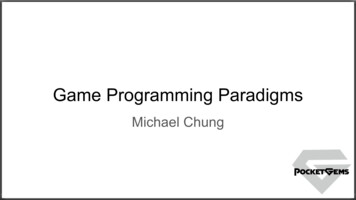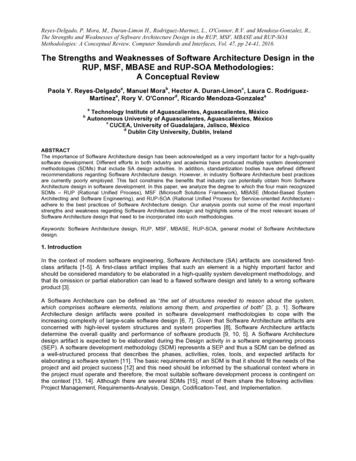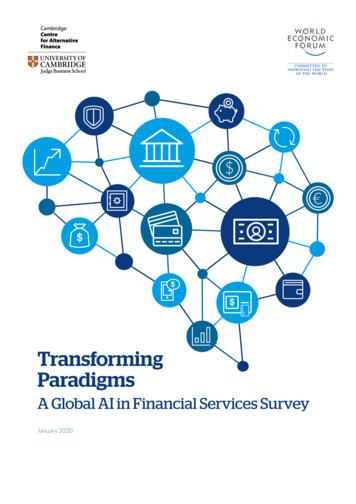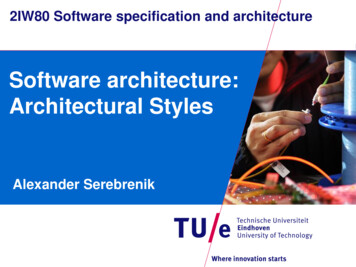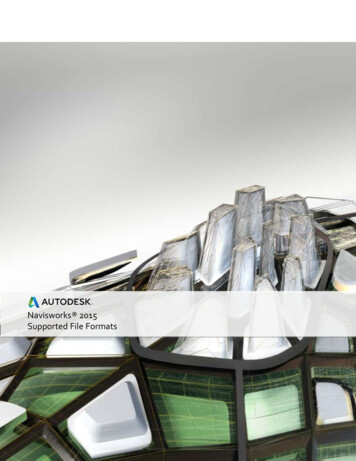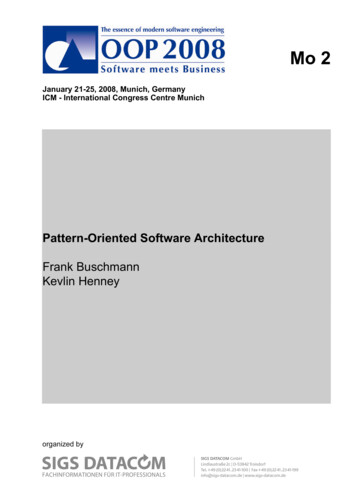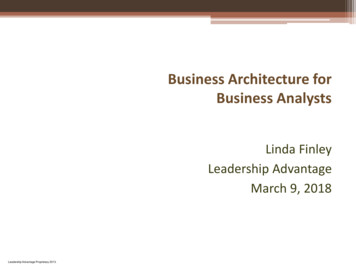
Transcription
Software Architecture Paradigms“We have found that understanding software architecture is the key todeveloping many important software solutions.”B. Stroustrup, 1991.Objectives . 31. Definitions . 42. Architecture Style [J. Peters and W. Pedrycz 2000]: . 43. Data Flow Systems . 83.1 Pipelines. 84. Call & return Systems . 94.1 Layered Architecture: . 91. Supervisor . 94.2 N-Tier Architecture : (www.n-tier.com) . 104.2.1 Motivations . 104.2.2 Architecture: . 111. Client/Server (C/S) . 112. Different Types of Architectures . 125. Independent Processes . 155.1 Communicating Processes: . 156. Repository. 186.1 Blackboard Architecture. 182. Action . 193. Action . 194. Action . 197. Architecture Evaluation: Good Structure . 237.1 Goals . 237.2 Cohesion . 233. Coincidental cohesion . 234. Logical cohesion. 245. Temporal cohesion . 256. Procedural cohesion . 257. Communicational cohesion . 268. Informational cohesion . 269. Functional cohesion . 277.3 Coupling . 28A. BellaachiaPage: 1
8.9.10. Content Coupling . 2911. Common Coupling . 3012. Control Coupling . 3113. Stamp Coupling . 3114. Data Coupling. 32Formal Definitions. 33Summary. 35A. BellaachiaPage: 2
Objectives An architecture design document is the key technical document used to determine whether the critical system requirements are met.Software design determines how requirements are realized as softwarestructures.This is the immediate step after the requirements engineering phase in thesoftware life-cycle.In software development, it is useful to organize architectures into familiesand associate families with typical applications: This will help reduce theoverall development timeWhere are we in the software life itecturesComponentsSoftware Component ArchitectureDSSA: Domain-Specific SoftwareArchitecturesFrameworksDesign PatternsWhichProgramminglanguage?A. BellaachiaPage: 3 .
1.Definitions A model for describing software architectures was introduced by Perry andWolf in 1992. A description of a software architecture consists of threebasic elements:- A processing element or component is a software structure thattransforms its inputs into required outputs.- A data element consists of information needed for processing orinformation to be processed by a processing element.- Connecting elements are the “glue” that holds different pieces of anarchitecture together.ArchitecturalElementsProcessing ElementsOrComponents2.Data ElementsConnecting ElementsArchitecture Style [J. Peters and W. Pedrycz 2000]: An architecture style is a pattern of structural organization in anarchitecture. It appears as a toolbox containing tools (architecture) useful inconstructing different kinds of software modules. Characteristics: A. BellaachiaTypes of components: Processing elements used to transform data(i.e., formatting routines in text formatting package).Types of connectors: Control and data paths between components.Page: 4
Constraints: Restrictions on processing, data, and allowable waysto “wire” components together. Architectural styles provide four things: Vocabulary: A set of design elements such as pipes, filters, client,severs, parsers, databases, etc.Design rules: These are the set of constraints that dictates how theprocessing elements should be connected.Semantic interpretation: An architectural style provides a welldefined meaning of the connected design elements.Analyses: Many styles provide analyses that can be performed onsystems build in that style, i.e., deadlock detection, scheduling, etc. Detailed Description:ConfigurationInterfaces or portsProcessing Elementor ComponentProcessing Elementor utes}o Components communicate through one or more ports or interfaces.o Connectors: can be implemented using shared variables, remoteprocedure call, and message passing.o An interface: user interface, variables, a method that can be called byanother component, events, etc.o Attributes define the behavior of the element: Components: run-time constraints, protocols, etc.A. BellaachiaPage: 5
Connectors: rate, capacity, latency, asynchronous vs.asynchronous, etc. Interfaces: direction of communication, buffering capacity,etc.o Configuration:o Also called topologyo Can be modeled as a graph where nodes are the componentsof the architecture and links are different connectors betweencomponents.o Help analyze performance of the architecture style: Bottleneck Longest path (System response) Etc. Example of software architecture: Architecture element: Internet Uniform Resource Locator (URL): Processing elements: Access method: ftp, http, telnet Data: Machine name, Directory name, File name. Connectors: // precedes machine name and / precedesdirectory name or file name. Architecture element: Application package: MS Word Processing elements or components: Spelling,grammar, Thesaurus, Word count, etc. Data element: File name Connectors: Pull-down menu and item buttons Categories: A. BellaachiaDataflow Systems:Pipelines (pipes & filters)Page: 6
A. BellaachiaBatch processing,Process controlCall-&Return:Object-oriented (OO)LayeredProcedure orientedIndependent-Process:Event-action systemDistributed systemCommunicating processesParallel BlackboardVirtual Machine:Intelligent systemRule-based systemInterpretersPage: 7
3.Data Flow Systems3.1 Pipelines This architecture style is modeled after assembly lines in manufacturing plants.The pipe consists of stages. When one stage completes its processing itsoutputs become the inputs of the following stage.In software engineering, pipeline architecture consists of a set of connectedprocessing elements called filters.A filter transforms its inputs and its results become inputs to the pipeconnected to the next filter.The data element in a pipe is usually called a stream.The connecting elements between filters are called pipes Example: A Unix shell programming commandPipes% cat filename sort tail -3 grep MacInput to sortInput to tailInput to grepPipeline indowsMacA. BellaachiaPage: 8
4.Call & return Systems4.1 Layered Architecture: Layered architecture style works well whenever system requirements callindependent tasks organized hierarchically. Architecture layers have been used in database, operating, computer-tocomputer communications, etc. Definitions: Example:A layered architecture is designed as a hierarchy of clientserver processes that minimizes interaction between layers.Each layer acts as a client for the module above it and acts asa server for the module below it in an architecture layer. MemoryMgmt Process and Timemgmt I/O systemsKernelExecutiveA. Bellaachia1. SupervisorUserPage: 9
User layer: provides utilities, application libraries, tools, andprogramming languages. Supervisor layer: provides command language interpreter (interfacebetween users and inner layers of VMS). Executive layer: provides record managements. Kernel layer: Handles I/O (device drivers), schedules and controlprocesses, manages memory. Advantages: Layered architecture provides an incremental approach to designing acomplex system. Maintainability: Layered can be easily maintainedand even replaced. Extendibility: new services (layers) can be easily added.4.2 N-Tier Architecture : (www.n-tier.com)4.2.1 Motivations N-Tier applications mean using whatever mix of ComputerHardware and/or Software Layers you need, in order to build amodular information system. What does N-tier mean? N-Tier means "Any Number of Tiers" No Limits Levels/Layers/Tiers Clients & Customers Objects & Components Servers & ServicesA. BellaachiaPage: 10
Programs partitioned into Tiers allow each layer or component part tobe developed, managed, deployed and enhanced independently. The N-Tier model of computing enables the overall performance andmaintainability of Client/Server systems to be substantially improved. This layered environment also simplifies code distribution, since mostof the business logic has been moved from the client to the server. Other advantages of Multi-Tier Client/Server architectures include: Changes to the user interface or to the application logic arelargely independent from one another, allowing theapplication to evolve easily to meet new requirements. The client is insulated from database and network operations.The client can access data easily and quickly without havingto know where data is or how many servers are on thesystem.4.2.2 Architecture: In a multi-tier environment, the client implements thepresentation logic (thin client). The business logic isimplemented on an application server(s) and the data resideson database server(s). A Multi-tier architecture is thus defined by the followingthree component layers:1. A front-end component, which is responsible for providingportable presentation logic;2. A back-end component, which provides access to dedicatedservices, such as a database server.3. A middle-tier component, which allows users to share andcontrol business logic by isolating it from the actual application;1. Client/Server (C/S) Client/Server is simply an architectural method of providinginformation to an end user; but that's where the simplicityends.A. BellaachiaPage: 11
Client/Server is a general description of a networked systemwhere a client program initiates contact with a separate serverprogram (usually on a different machine) for a specificfunction or purpose. The client exists in the position of therequester for the service provided by the server.2. Different Types of Architectures The term Client/Server has traditionally been associated with adesktop PC connected over a network to some sort of SQLdatabase server. One-Tier Monolithic (C/S) ArchitecturesThe Information Technology (IT) industry, have been practicinga simple form of Client/Server computing since the initialinception of the mainframe. That configuration, a mainframehost and a directly connected, (unintelligent) terminal constitutesa one-tier C/S system. Two-Tier Client/Server Architectures In two-tier client/server architecture, the client communicates directlywith the database server. The application or business logic either resideson the client or on the database server in the form of stored procedures. A two-tier (C/S) model first began to emerge with the applicationsdeveloped for local area networks in the late eighties, and was primarilybased upon simple file sharing techniques implemented by X-base styleproducts (dBase, FoxPro, Clipper, Paradox, etc.). Three-Tier Client/Server Architectures A newer generation of Client/Server implementations takes thissegmented model a step further and adds a middle tier to achieve a '3tier' architecture.A. BellaachiaPage: 12
Fat Clients The two-tier model initially involved a non-mainframe host, (a networkfile server) and an intelligent "fat" client where most of the processingoccurs. This configuration did not scale well however, to facilitate large or evenmid-size information systems (greater than 50 or so connected clients).A. BellaachiaPage: 13
Fat Servers An alternative 'Thin' Client --- 'Fat' Server configuration, where theuser invokes procedures stored at the database server. The 'Fat' Server model, is more effective in gaining performance Fat Middle A multi-tier architecture augments traditional client/server and two-tiercomputing by introducing (one or more) middle-tier components. The client system interacts with the middle-tier via a standard protocolsuch as HTTP or RPC. The middle-tier interacts with the backend servervia standard database protocols such as SQL, ODBC and JDBC. This middle-tier contains most of the application logic, translating clientcalls into database queries and other actions, and translating data fromthe database into client data in return.A. BellaachiaPage: 14
5.Independent Processes5.1 Communicating Processes: A communicating process is an object with input and output ports. A port is an identifiable means of “wiring” process together. Ports areconnected by input and output channels. Processes are connected together to form different topology, i.e., mesh,tree, etc. A communicating processes form of architecture includes: Processes andchannels to communicate these processes. Examples: Pipeline, Mesh, Tree Process-based architecture can be described using CommunicatingSequential Processes (CSP) specification language. CSP was introduced byHoare (1978, 1985). The following table gives the notation used by CSP:A PP QP;QB*PEvent a then process P(a P b Q)Choose a P or b Q, depending on evaluation of a, b(assume a b)Iterate PProcess P named VMAssign value e to xOutput value of message e on channel bInput message e from channel b*PVM PX: eB!eB?eA. BellaachiaP in parallel with QP successfully followed by QWhile b repeat PPage: 15
Example 1:msgmsgRight filterLeft filterpipe (left?msg - (right!msg - pipe))message InputExample2: from Left filter & output message to Right filtermsgP pe3Let P be the name of a process that supplies the input to the pipeline,and out is the process that output the final result of the pipeline.Fi be filters of the pipe.Message msg is received by the left channel, output by the rightchannel, and then the process reverts back to pipe (waiting for thenext message).Label all the pipelines.Describe the overall topology of the architecture.Give the details of individual pipelines.1. Labels the pipelines:Pipe0, pipe1, etc.2. Topology:Pipeline *(P;pipe0;F1;pipe1;F2;pipe2;F3;pipe3;out)3. Details:Each pipei is described as follows:A. BellaachiaPage: 16
Pipe0 (P ? msg - (F1 ! msg - pipe0) // input from P sent to filter F1Pipe1 (F1 ? msg1 - (F2 ! msg1 - pipe1) // input from F1 sent to filter F2Pipe2 (F2 ? msg2 - (F3 ! msg2 - pipe2) // input from F2 sent to filter F3Pipe3 (F3 ? msg3 - (out ! msg3 - pipe3) // input from F3 sent to filter out Example 3: a T pipemsgmsgF1F11msgF12T pipetpipe (F1 ? msg - ( F11 ! msg - tpipe F12 ! msg - tpipe))Example 4: Choice “ ”F1P1P3F4F3P2F2P *((F1;P1) (F2;P2));F3;P3;F4)P1 F1?m (F3!m P1)P2 F2?m (F3!m P2)P3 F3?m (F4!m P3)A. BellaachiaPage: 17
6.Repository6.1 Blackboard Architecture The blackboard architecture is used as a central repository for all sharedinformation It is a knowledge-based form of repository appropriate in applicationsrequiring cooperative problem solving by virtual minds, human minds, orboth (Hayes-Roth 1985). There are three basic components of a blackboard architecture: Knowledge source: are independent expert panel members (processes)for particular problem parts. Their actions are triggered by satisfaction ofparticular conditions. Blackboard: Repository of problem-solving state data, organized in anapplication-dependent hierarchy: level-n (highest) to level-1 (lowest). Control: (1) monitors information in the blackboard, (2) maintainspermissible combinations of knowledge source activations, (3) schedulespending knowledge-source activations (KSA), (4) evaluates localproblem specific to the blackboard.A. BellaachiaPage: 18
ConditionInformation level-n .KS12. ActionInformation level-iConditionKS1 .3. ActionInformation level-1ConditionKS14. ActionMonitorEvaluateQueueSchedule1. An event on the blackboard panel can simultaneously trigger diverseknowledge. But only one knowledge source can run a task at a time.2. Once a condition in a knowledge source is satisfied, this adds a knowledgeactivation resource record (KSAR) to a queue.3. The scheduler selects the appropriate KSARs and calls the responsibleknowledge sources to run the tasks. Tasks are run after all preconditions havewritten their KSARs.A. BellaachiaPage: 19
Backboard KSAsChoosingactionEvaluatependingKSAsStrategy Benefits: Integration of knowledge sources is managed directly by thecontrol system.Modularity -- each knowledge source is independent which easesdevelopment and maintenance.Flexibility -- the Blackboard architecture allows blackboardapplications to adapt to changing requirements much more flexiblythan the rigid traditional procedural software applications.Software reuse -- accrues in three ways: The independence and modularity of knowledge sourcesmeans that new applications can easily be constructedusing existing knowledge sources. Legacy (traditional procedural) software investments canbe preserved because they can be incorporated asknowledge sources. The Blackboard itself is application independent, and iseasily applied to new problem domains. A. BellaachiaExtensibility -- new knowledge sources may be developed andadded without impacting the existing systemPage: 20
Examples Hearsay II Implementation Mobile Robot: Solution 4: Blackboard Architectureo http://www.cs.cmu.edu/ ModProb/MRsol4.htmlo It was used in the NAVLAB project, as part of the CODGER system[Shafer86].o The components of CODGER are:o The "captain", the overall supervisor.o The "map navigator", the high level path planner.o The "lookout", a module that monitors the environment forlandmarks.o The "pilot", the low level path planner and motor controller.A. BellaachiaPage: 21
o The perception subsystem, the modules that accept the raw inputfrom multiple sensors and integrate it into a coherentinterpretation.o (R1) The components (including the modules inside the perceptionsubsystem) communicate via the characteristic central database of theblackboard systems. Modules indicate their interest in certain types ofinformation. The database returns them such data either immediately orwhen some other module inserts them into the database. For instance,the lookout may watch for certain geographic features; the databaseinforms it when the perception subsystem stores images matching thedescription.o (R2) The blackboard is also the means for resolving conflicts oruncertainties in the robot's world view. For instance, the lookout'slandmark detections provide a reality check for the distance estimationby dead-reckoning, both stored in the database. The modules responsiblefor the uncertainty resolution register with the database to obtain thenecessary data.A. BellaachiaPage: 22
7.Architecture Evaluation: Good Structure7.1 Goals Maximize interaction within each (cohesion) and minimizeinteraction between components (coupling)7.2 Cohesion The degree to which the internals of a component are related A component has high cohesion if all of its elements are stronglyrelated: elements are grouped together for a logical reason, not justby chance. They cooperate to achieve the common goal of thecomponent. High cohesion well-designed reusable component There are seven cohesion levels:1. Coincidental cohesion BAD2. Logical cohesion3. Temporal cohesion4. Procedural cohesion5. Communication cohesion6. Informational cohesion7. Functional cohesion GOOD3. Coincidental cohesion A component has coincidental cohesion if it performscompletely unrelated actions.A. BellaachiaPage: 23
Ex.Component (p1,p2,p3)BeginUpdate item record (p1);Delete orders(p2);Insert new customer info(p3);End Problem: Not reusable.4. Logical cohesion A component has logical cohesion when it performs a series ofrelated actions, one of which is selected by the callingcomponent. Ex. New operation(function code,p1,p2,p3)/* p1 and p3 are not used when this function is called witha function code 7 and less than 20 */ A component performing all I/O operations: disk, tape,printers, etc. Problems: Component interface is difficult to understand Difficult to maintainA. BellaachiaPage: 24
5. Temporal cohesion A component has temporal cohesion when it performs a series ofrelated actions in time. Ex. An initialization component:Initial several unrelated objects: customer table,item table, etc. Components to manipulate these objects are located inother components Problems: Maintenance and Reusability6. Procedural cohesion A component has procedural cohesion if it performs a series ofactions related by the sequence of steps to be followed by theproduct. Ex.Read(part number, part table);Update(repair record)maintain(cutomer table) Better than temporal cohesion Problem: Reusability: actions are weakly related.A. BellaachiaPage: 25
7. Communicational cohesion A component has communicational cohesion if it performs aseries of actions related by the sequence of steps to be followedby the product and if all actions are performed on the same data. Better than procedural cohesion: actions of the component areclosely related. Ex.Update record(R,table);Write record(R,audit table);8. Informational cohesion A component has informational cohesion if it performs anumber of actions each with its own entry point, withindependent code for each action, all performed on the samedata structure. All actions in an informational cohesion level are closelyrelated. Informational cohesion is optimal for OO. Ex: ADTDefinition of item tableInitialization of item tableUpdate item tablePrint item tableA. BellaachiaPage: 26
9. Functional cohesion A component that performs one action and achieves one singlegoal has functional cohesion. Ex.Compute(sales commission); Communicational cohesion: reusable, easy to maintain and tounderstand.A. BellaachiaPage: 27
7.3 Coupling Originally designed to support programming in the large Components Encapsulation InterfacesUncoupledno dependenciesLoosely coupledsome dependenciesHighly coupledmany dependencies Coupling measures the degree to which the components of a designare related. Ex. Component A calls a routine provided by B or access an objectof component B.Component A and B have high coupling if they depend oneach other heavily. low coupling is a desirable feature. Components are: Components are ReusableA. BellaachiaPage: 28
Components are easily tested and modified Reduction of the maintenance cost There are five coupling levels:1. Data coupling2. Stamp coupling3. Control coupling4. Common coupling5. Content coupling GOOD BAD1. Content Coupling Two components are content-coupled if one directly references thecontents of the other. Ex. Component p modifies a statement of component q Component p refers to local data of component q Component p refers to a local label of component q Problems: Any change to q may require a change to p. It is impossible to reuse component p without reusing qA. BellaachiaPage: 29
2. Common Coupling Two components are common-coupled if they both have access tothe same global data. Ex.Component pComponent qGlobal Data Both component p and component q read and write a recordof a database. Read-only is not a common coupling. Problems: Unreadable code: While(global variable 0){if(local variable val)function 1();elsefunction 2();} global variable may be changed by function 1() orfunction 2(). Modification of the declaration of theglobal variable may yield a modification of everycomponent that accesses the global variable. Common-coupled are not reusable They depend on components where globalvariables are declared.A. BellaachiaPage: 30
3. Control Coupling Two components are control-coupled if one passes an element ofcontrol to the other component; one component explicitly the logicof the other. Ex.If p calls q and q passes back a flag to p that says, "I amunable to perform the requested action Ai, please write themessage number 1020. q informs p as what to do Control-coupling4. Stamp Coupling Two components are stamp-coupled if a whole data structure ispassed as an argument but the called component operates on onlysome of the individual components of that data structure. Problems: Data access cannot be controlled: More data is passedthan needed. Optimization: Passing different variables slower Passing one single record faster Knuth's first law: Don't!!A. BellaachiaPage: 31
Required optimization Leave it to the experts Knuth's second law: Not yet!!5. Data Coupling Two components are data-coupled if all arguments arehomogeneous data items. It is a desirable goal. Data-coupled components are easier to maintain.A. BellaachiaPage: 32
8.Formal Definitions A software system can be modeled as a graph. Each node (Fi) in the graphcorresponds to a method (function or procedure) call of a component and eachedge corresponds to an interaction (dependency) between methods in thesystem: Cohesion:o The cohesion of a component is the extent to which its individualmethods are needed to perform some tasks. Cohesion of a component isdefined in terms of the ratio of internal relationships to the total numberof relationships. The cohesion of a component mi is:CH(mi) Ri /(Ri Re)Where Ri is the number of internal links and Re is the number ofexternal links.C1F0C2F1F2F3F4F5F6o Example:A. BellaachiaPage: 33
The cohesion of C1 and C2 in Figure 1 are:CH(C1) 2/3CH(C2) 1/2o The cohesion of a software system is the average cohesion of all its ncomponents:CH (1/n) * CH(Ci) for all Ci of the system.o Example: The cohesion of the system in Figure 1 is:CH 7/12 Couplingo The coupling of a component is the ratio of the number of external linksto the total number of links:CP(Ci) Re /(Ri Re)o The coupling of a system is the average coupling of all its n components:CP (1/n)* CP(Ci) for all mi of the system.A. BellaachiaPage: 34
9.Summary Architectural Elementso Processing elementso Connecting elementso Data Elementso Configuration file Architectural Styles (major ones)o Dataflow Systems Pipelines Each layer is client for layer below it output of one stage input to next Example: Compilerso Call & Return Systems Layered Each layer is client for layer below it advantages: incremental, extendable N-tier / Client-Server layers can be developed independently Examples: Operating Systems, Web-based applicationso Independent-Process Communicating Processes: Using CSP to describe different process topologieso Repository Blackboard central repository for shared info 3 components – knowledge source, controller, repository(blackboard) Example: no one single answer – fingerprintsA. BellaachiaPage: 35
A. Bellaachia Page: 3 Objectives An architecture design document is the key technical document used to determine whether the critical system requirements are met. Software design determines how requirements are realized as software structures. This is the immediate step after the requirements engin

